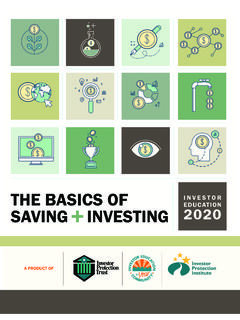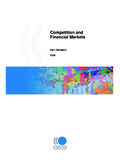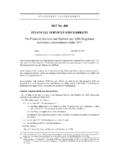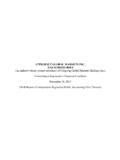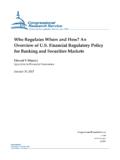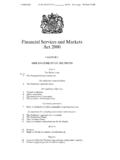Transcription of UNIT THE BASICS 2 UNIT 2 I Introduction to Financial Markets
1 UNIT. THE BASICS 2. UNIT 2 I Introduction to Financial Markets TEACHING STANDARDS/KEY TERMS. 12(b)-1 fees Blue chip companies Bond market Caveat emptor Commodity Futures Trading Commission (CFTC). Common vs. preferred stock Consumer Consumer Financial Protection Board (CFPB). Coupon rate Dividend Dollar cost averaging Dow Jones Industrial Average (DJIA). Economic growth Economic indicators Economy Exchange Financial Industry Regulatory Authority (FINRA). Financial Markets Free enterprise system Futures Gross domestic product Load vs. no-load market economy Markets Mutual funds NASDAQ Stock market Net Asset Value (NAV). New York Stock Exchange (NYSE). North American Securities Administrators Association (NASAA). 2020 INVESTOR EDUCATION.
2 2 1. I. UNIT. 2 THE BASICS . Private vs. public companies Prospectus Risk tolerance Securities and Exchange Commission (SEC). State securities regulators Stock Stock market Supply vs. demand Unit Objectives: INDIVIDUALS WILL: Understand the relationship between risk and return. Learn about Financial Markets and investment products. Explore conditions that affect market prices. Grasp the extent and limits of government regulation of the Financial Markets . Unit Teaching Aids: LESSON 1: Myths Vs. Realities: Risk and Returns (Handout/Overhead). How Financial Markets Work LESSON 2: market Questionnaire (Worksheet). Public and Private Companies Company Questionnaire (Worksheet). LESSON 3: Reading Stock Tables (Handout).
3 What Makes Stock Prices Rise and Fall? Evaluating Stock Prices (Worksheet). LESSON 4: The Role of Government in Securities Regulation Securities Regulation Research Project (Worksheet). UNIT TEST: (Test and Answer Key). I. 2 2 INVESTOR EDUCATION 2020. UNIT. THE BASICS 2. For Instructors Why Teach This Unit? The youth and young adults of today are the investors of tomorrow or should be. It is important, therefore, that students gain a basic understanding of how the Financial Markets function. This Unit is designed to help take the mystery out of the Financial marketplace by demonstrating its strong presence in students' everyday lives and by providing a basic understanding of how Financial Markets work. A person does not have to be rich to start investing.
4 Today, more than half of all American adults are investors. Very few of these people are Financial geniuses driving fancy cars and living in mansions. Instead, the vast majority of today's investors are teachers, doctors, carpenters, government employees, lawyers, and so on. Many started out investing very modest amounts of money as little as $25 or $50 a month. The Financial Markets will play a major role in the lives of most Americans. How much will gasoline cost? How high will the interest be on your first or next home? market forces already affect daily life in many ways and will become only more pronounced in the future. LESSON 1: Understanding Risk and Return Investors run the risk of losing their money when they invest, but they stand to gain a return more money if the investment is profitable.
5 The rule of thumb of the investing world is as follows: The bigger the risk, the bigger the potential payoff. We learned in Unit 1 that risk is the chance one takes that an investment will lose money or earn less than it might otherwise earn. It follows that risk tolerance is how much risk an individual can afford to take each person's ability to ride out the ups and downs of the market and the potential of losing what they have invested. Risk tolerances vary from person to person and at different stages in the life cycle. Young adults who invest can withstand market fluctuations to see their investments increase in value over the years and can afford to take greater investment risks than people who are older or approaching retirement.
6 People who can't afford to lose the principal of their investment should select savings and investments with less risk. On the other hand, investments that guarantee the safety of principal may not maintain purchasing power in times of high inflation. 2020 INVESTOR EDUCATION. 2 3. I. UNIT. 2 THE BASICS . Students should learn the six major types of investment risk: Interest rate risk is the risk that the value of an investment will decrease due to a rise in interest rates. The value of a fixed-return investment decreases when interest rates go up and increases when interest rates go down. Business failure risk is the risk that the business will fail and the investment will be worthless or that the business will be less profitable than expected.
7 How well will the business do in both good and bad economic times? market price risk is the risk that the price of an investment will go down. Many factors influence whether the price of an investment will go up or down. Few investors can consistently predict the ups and downs of the market . Investors may experience a loss if they must sell when the market price is down. Inflation risk is the risk that the Financial return on an investment will lose purchasing power due to a general rise in prices of goods and services. Investment returns must be more than what the rate of inflation is in order to truly increase in value. Political risk is the risk that government actions such as trade restrictions or increased taxes will negatively affect business profits and investment returns.
8 Fraud risk is the risk that the investment is designed to deceive and misrepresent facts. In every case of investment fraud, the seller wins while the investor loses. LESSON 2: How Financial Markets Work Markets are the meeting place where buyers and sellers come together and determine prices. A Financial market is a place where firms and individuals enter into contracts to buy or sell a specific product such as a stock, bond, or futures contract. Buyers seek to buy at the lowest possible price and sellers seek to sell at the highest possible price. The market for stocks and other investments is similar in concept to a farmer's market where growers display their produce for consumers to buy. Financial Markets are where money and people come together with the vibrant energy of free enterprise.
9 Supply and Demand In this teaching guide, the focus is on market economies economic systems in which individuals own and operate businesses. All Markets comprise two basic participants: the buyer and the seller. In a Financial market , the buyer is the investor. The investor may be an individual, organization, or company. A buyer or investor may also be referred to as a consumer one who buys or uses products or resources. The seller is the entity offering the product and may be an individual, company, government agency, or other organization. I. 2 4 INVESTOR EDUCATION 2020. UNIT. THE BASICS 2. Prices for goods or services in any market depend largely on the supply and demand of the product or service. Demand is the quantity of goods that consumers purchase in a given time period.
10 The law of demand suggests that the demand for a product and the cost of that product have an inverse relationship: as prices increase, demand for that product decreases. Supply is the amount of products or services that a producer is able to make available to consumers at a given time. The law of supply suggests that as a product's price increases, the quantity supplied to buyers also tends to rise. If the supply of a product is insufficient to meet the demand, consumers will pay more. On the other hand, if the supply outweighs the demand, the price will remain low. Discuss with your students some current examples of consumers paying more or less because of an imbalance of supply and demand. An auction is an excellent place to study the effects of supply and demand.





